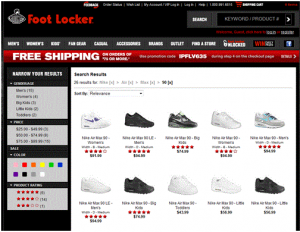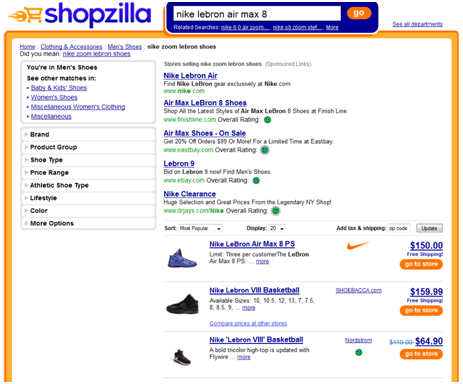Lebron James, Where Are My Shoes? A Guide to Slam-Dunk PPC Landing Pages.
 At Vovia, we’ve got a few sports nuts. In honor of the NBA championship starting this week, I’m going to dive into a topic that is rarely touched on and in need of a good review using a basketball theme! Matching relevant landing pages to your ads can be a game-changer for your PPC campaign. In the spirit of the NBA finals, we’re going to do a little shoe-shopping.
At Vovia, we’ve got a few sports nuts. In honor of the NBA championship starting this week, I’m going to dive into a topic that is rarely touched on and in need of a good review using a basketball theme! Matching relevant landing pages to your ads can be a game-changer for your PPC campaign. In the spirit of the NBA finals, we’re going to do a little shoe-shopping.
The Phrase
I really like Lebron James and I could use some new kicks, so let’s imagine I’m doing a search for the star’s trademark footwear. The Google search phrase we’ll use is “Nike Lebron Air Max 8.” Let’s keep in mind the criteria for a good PPC ad:
- A compelling, relevant title that utilizes your keyword phrase
- A listed benefit/feature
- A strong call to action
- Intriguing/engaging ad copy
With that in mind, let’s take a look at two very different results for my query:
Foot Locker Ad and Landing Page

This ad is a decent start. Some of the keyword phrase is in the headline – but it’s not 100% relevant to what I was looking for. That’s going to reduce my likelihood of clicking. Looking beyond the headline, I’m not too crazy about the sub headlines. They don’t offer a clear benefit or a compelling call to action. Sure, a “huge selection” is somewhat intriguing, but why should I click this ad instead of another one? In Foot Locker’s defense, most larger sites have thousands of ads running at a time and so they adopt a bulk, cookie-cutter format. Lastly, the call to action is missing, another strike against a potential click through. I realize you can’t squeeze a call to action in every ad, so it’s about being creative. In our experience, being creative with your copy can help you win too – but be sure to A/B test and monitor!
Can I Buy Now?

So, we’ve determined that the PPC ad was decent – but Footlocker’s landing page is full of question marks. For starters, the product I came to buy isn’t even on the page. Sure, there’s a variety of Nike Air shoes, but NO Lebron Zoom shoes anywhere in sight. This is what I call the “no-name food section”- you’re looking for the branded food but you end up with other, less-cool styles. Again – in Footlocker’s defense this is probably one of thousands of ads they’re running. But wouldn’t it have made more sense to take me RIGHT to the Lebron James product page?! What happened here is that Footlocker forgot to account for searches for highly popular shoe styles and instead tried to have a broad ad as a catch-all. We’re left with two things: a frustrated buyer and a landing page that’s only partially relevant to the search. I’m sure when they look at their bounce rate it will tell a not-so-beautiful story.
Shopzilla Ad and Landing Page

Here’s a better example. There’s a clear headline that matches what I was looking for. The sub headlines are catchy, timely and offer features and benefits. Best of all, there’s a call to action. The sub-domain is an added bonus as it has our keywords in it.
Swish – Two Points!
 OK – now we’re getting somewhere! I see THE shoe I wanted. It’s available and my finger is ready to click on the go to store button. If the price is right, there’s a good chance I’ll be buying from this page because they gave me exactly what I was looking for. That’s the lesson here – don’t make people think. Don’t make people do work. When someone clicks on your ad, they want to see exactly what they came for – right away.
OK – now we’re getting somewhere! I see THE shoe I wanted. It’s available and my finger is ready to click on the go to store button. If the price is right, there’s a good chance I’ll be buying from this page because they gave me exactly what I was looking for. That’s the lesson here – don’t make people think. Don’t make people do work. When someone clicks on your ad, they want to see exactly what they came for – right away.
The New Game Plan
Here’s a simple actionable list you can use when determining how to match your PPC keywords to specific landing pages.
1. Be specific. Popular products deserve their own landing pages. Take the time and effort to create individual ad groups for highly sought after products. Don’t waste your time or money trying to divert the viewer to a product they didn’t come for. Think of it this way – your ad provides the alley-oop, while the landing page should be the slam-dunk to the sale.
2. Write Effective Ads. Don’t forget to put the product name in the headline. Make sure your sub-headlines have a call to action and list the benefits of the product.
3. Don’t Make People Think! Make sure your landing pages offer customers exactly what they were looking for. Don’t make people search once they’ve arrived – they may get frustrated and you’ll lose the sale.